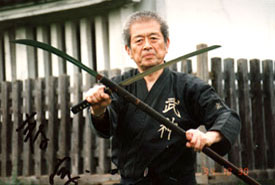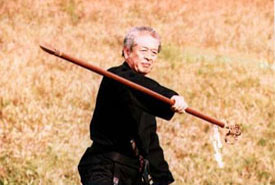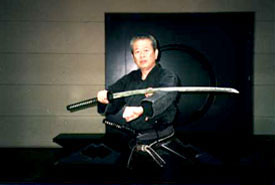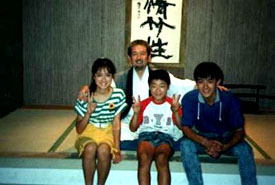Hatsumi Masaaki
Birth
Dr. Hatsumi Masaaki was born Hatsumi Yoshiaki on December 2, 1931, in Noda, Chiba Province. He later changed his name to Masaaki. Other names of Hatsumi are Toratsugu, Tetzusan and Hisamune. At the age of 7, Hatsumi learned kendo from his father. He also trained in Aikidō, Jūdō, and Karate. At school, Hatsumi practiced gymnastics and boxing and was captain of the soccer team. He practiced dancing, which helped him learn Budō. In high school, he continued boxing and engaged in judo. He studied dramaturgy and theater studies.
Theater Studies and Osteopathy
Hatsumi received his degree in drama and osteopathy from Meiji University in Tokyo. He then set up a practice for osteopathy. While at university he achieved 4th dan in jūdō, which was rare at his age.
Jūdō Training With Americans

He was asked if he could practice judo with the American soldiers at Yokote Army Base. Americans, being taller and stronger, mastered judo in a matter of months, which would take a Japanese man many years of hard practice. Hatsumi doubted the effectiveness of judo when one could not win against larger, stronger opponents as a smaller or weaker fighter.
He began to search for real martial arts and practiced kōbujutsu juhappan with Ueno Sensei. After three years he had mastered the style and his teacher said there was nothing more he could teach him. He advised Hatsumi to go to Nara and find a capable teacher.
Meeting With Takamatsu

When Hatsumi was 26 years old, he met Takamatsu Toshitsugu, who was nicknamed Moko no Tora (Mongolian Tiger).
In taijutsu you can use movement and distance to defeat a physically superior opponent.
From then on, Hatsumi traveled ten hours a week for 15 years to his master via the island of Honshū. He left Noda on Friday night, staying with his master and training with him over the weekend. On Sunday night he left again and made the long journey back to open his practice again on Monday morning.
After passing the sakki test, Takamatsu gave him the menkyōkaiden of the 9 Warriors Ryūha.
Hatsumi’s Sakki Test
Hatsumi reports that one day his master asked him to sit down and close his eyes. Then he left the room. After several hours, Hatsumi felt a heavy pushing force from behind and pictured a body split in two in his mind’s eye. Intuitively, Hatsumi performed a sideways roll. At that moment he heard his teacher say Well done, you did it, you can now open your eyes
. The master had approached silently from behind with a sharp sword and executed a swipe.
Takamatsu’s Death
A year later, Takamatsu Sensei died. Before that, he told Hatsumi that he taught him everything he knew, thus repaying his masters for their kindness.
He decided that Hatsumi was the most capable of his students and should therefore carry on the legacy. Hatsumi became the new sōke.
Founding of the Bujinkan

He named the honbu Dōjō Bujinkan Dōjō in honor of his teacher. The dojo has been at his house. More recently he has built a new dojo and now lives in a house in the country.
At the age of 30, he married his wife Mariko.
Seminars Worldwide
Hatsumi traveled around the world several times a year, holding seminars and taikai (Big Gathering, Ninja Events). Due to his old age and to take care of his wife, Hatsumi now only stays in Japan. However, he still trains occasionally in the honbu Dōjō (main training hall in Tōkyō).
Awards and Honorary Degrees
He has received numerous military and public awards worldwide. He received two more doctorates, one in philosophy and one in science.
1986 was awarded the Black Belt’s Instructor Of The Year Award.
He is a scientist, painter, actor, musician, singer, and author who has written countless columns in newspapers and magazines has written many books on Ninjutsu and published the Bujinkan magazine sanmyaku (mountain range).

He has shot more than 25 videos and participated in many films: Shinobi no Mono, You live only twice (James Bond), 50 episodes of the popular children’s series Jiraya and Suteki no Mummy.
He is considered a national treasure in Japan and is one of the most important martial artists in the world.
Because of the unbelievable complexity of the schools, he decided not to train them separately, but to train them as a unit.
Training under Hatsumi is said to have been very hard at first, but in 1988, at the beginning of the Heisei period (Heisei means to become peaceful), he decided to adapt the Bujinkan to this aspect and toned down the training.
Since 1995 the martial art in Bujinkan has been uniformly called Budō Taijutsu.
Meister von neun Schulen
Hatsumi ist legitimer Nachfolger der neun Ryūha:
- 34. sōke – Togakure-Ryū Ninpō
- 28. sōke – Gyokko-Ryū koshi jutsu
- 26. sōke – Kukishinden-Ryū happōhikenjutsu
- 26. sōke – Shinden-fudo-Ryū daken taijutsu
- 21. sōke – Gyokushin-Ryū Ninpō
- 19. sōke – Koto-Ryū koppō jutsu
- 17. sōke – Takagi-yohsin-Ryū jutaijutsu
- 15. sōke – Gikan-Ryū koppō jutsu
- 14. sōke – Kumogakure-Ryū Ninpō